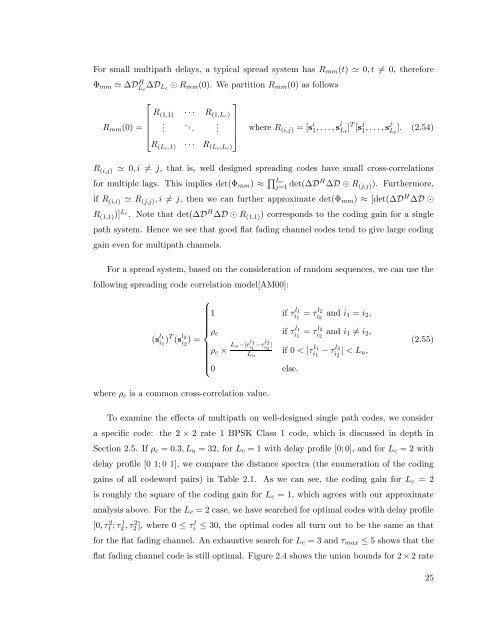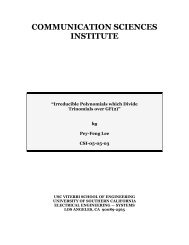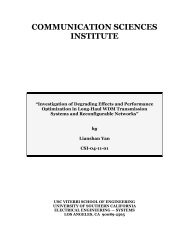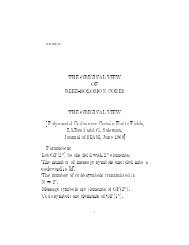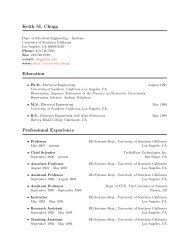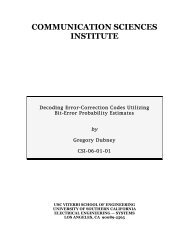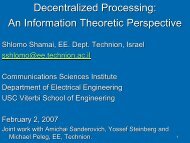Space-Time Block Codes for Wireless Systems - The ...
Space-Time Block Codes for Wireless Systems - The ...
Space-Time Block Codes for Wireless Systems - The ...
Create successful ePaper yourself
Turn your PDF publications into a flip-book with our unique Google optimized e-Paper software.
For small multipath delays, a typical spread system has R mm (t) ≃ 0, t ≠ 0, there<strong>for</strong>e<br />
Φ mm ≃ ∆D H L c<br />
∆D Lc ⊙ R mm (0). We partition R mm (0) as follows<br />
⎡<br />
⎤<br />
R (1,1) · · · R (1,Lc)<br />
R mm (0) =<br />
.<br />
⎢ . .. . ⎥<br />
⎣<br />
⎦ where R (i,j) = [s i 1, . . . , s i L t<br />
] T [s j 1 , . . . , sj L t<br />
]. (2.54)<br />
R (Lc,1) · · · R (Lc,L c)<br />
R (i,j) ≃ 0, i ≠ j, that is, well designed spreading codes have small cross-correlations<br />
<strong>for</strong> multiple lags. This implies det(Φ mm ) ≈ ∏ L c<br />
j=1 det(∆DH ∆D ⊙ R (j,j) ). Furthermore,<br />
if R (i,i) ≃ R (j,j) , i ≠ j, then we can further approximate det(Φ mm ) ≈ [det(∆D H ∆D ⊙<br />
R (1,1) )] Lc . Note that det(∆D H ∆D ⊙ R (1,1) ) corresponds to the coding gain <strong>for</strong> a single<br />
path system. Hence we see that good flat fading channel codes tend to give large coding<br />
gain even <strong>for</strong> multipath channels.<br />
For a spread system, based on the consideration of random sequences, we can use the<br />
following spreading code correlation model[AM00]:<br />
(s l 1<br />
i1<br />
) T (s l 2<br />
i2<br />
) =<br />
where ρ c is a common cross-correlation value.<br />
⎧<br />
1 if τ l 1<br />
i 1<br />
= τ l 2<br />
i 2<br />
and i 1 = i 2 ,<br />
⎪⎨ ρ c if τ l 1<br />
i 1<br />
= τ l 2<br />
i 2<br />
and i 1 ≠ i 2 ,<br />
ρ c × Lu−|τ l 1<br />
i1 −τ l 2<br />
i2 |<br />
L u<br />
if 0 < |τ l 1<br />
i 1<br />
− τ l 2<br />
i 2<br />
| < L u ,<br />
⎪⎩ 0 else.<br />
(2.55)<br />
To examine the effects of multipath on well-designed single path codes, we consider<br />
a specific code: the 2 × 2 rate 1 BPSK Class 1 code, which is discussed in depth in<br />
Section 2.5. If ρ c = 0.3, L u = 32, <strong>for</strong> L c = 1 with delay profile [0; 0], and <strong>for</strong> L c = 2 with<br />
delay profile [0 1; 0 1], we compare the distance spectra (the enumeration of the coding<br />
gains of all codeword pairs) in Table 2.1. As we can see, the coding gain <strong>for</strong> L c = 2<br />
is roughly the square of the coding gain <strong>for</strong> L c = 1, which agrees with our approximate<br />
analysis above. For the L c = 2 case, we have searched <strong>for</strong> optimal codes with delay profile<br />
[0, τ1 2; τ 2 1, τ 2 2], where 0 ≤ τ i l ≤ 30, the optimal codes all turn out to be the same as that<br />
<strong>for</strong> the flat fading channel. An exhaustive search <strong>for</strong> L c = 3 and τ max ≤ 5 shows that the<br />
flat fading channel code is still optimal. Figure 2.4 shows the union bounds <strong>for</strong> 2 × 2 rate<br />
25


